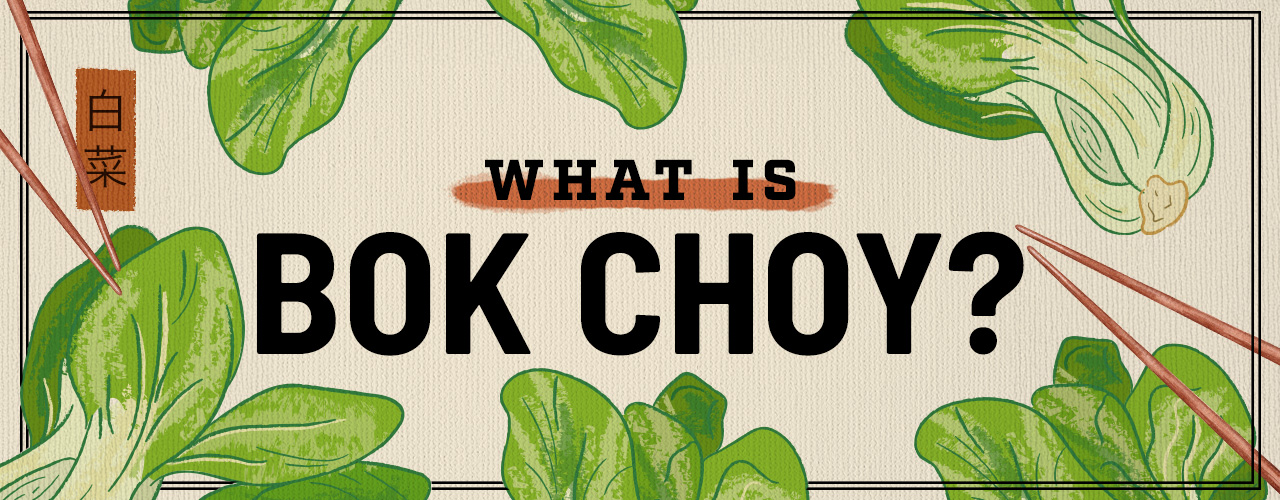When you pair the rise of Asian fusion cuisine with the ever-increasing public health consciousness, you have fertile soil for bok choy to take root in the national palate. You can cook bok choy quickly at high temperatures without it losing its crunch, making it a favorite among chefs who want to add a fresh and vibrant element to their dishes. But what exactly is bok choy? We’ve created a comprehensive guide to this leafy green vegetable to help you incorporate it into your commercial kitchen.
What Is Bok Choy?

Bok choy is a cruciferous Brassica vegetable that belongs to the cabbage family. Unlike traditional cruciferous vegetables grown in the United States, such as red and green cabbages, Brussels sprouts, and broccoli, bok choy does not form a compact "head." Instead, it is a non-heading cabbage characterized by its thick, crunchy white stems and broad green leaves. Every part of bok choy is edible, whether raw or cooked, making it a versatile ingredient used in stir-fries, soups, and salads.
Also known as Chinese cabbage, bok choy has a rich history dating back over 1,500 years in China. While it may not be as widely recognized in the United States as other cabbages and cruciferous vegetables, bok choy has been cultivated in North America for over a century. It is a popular ingredient in classic Asian dishes and a great way for restaurants to craft healthy, Asian fusion meals.
What Does Bok Choy Taste Like?
Bok choy has a mild, slightly peppery taste that is often likened to cabbage, but with a fresh, grassy flavor. The white stalks of bok choy provide a crunch, adding a refreshing element to dishes. Its leaves have a softer texture with a slightly bitter undertone, sometimes likened to mustard greens. Compared to other leafy greens, bok choy has a mild, umami flavor and is often referred to as a "gateway green" for those looking to incorporate more leafy greens into their diet.
What Does Bok Choy Look Like?
Bok choy is characterized by its thick, white stalks and dark green leaves. When cooked, bok choy retains its vibrant color and adds visual appeal to stir-fries.
How to Cook Bok Choy

Whether you prefer a quick stir-fry or a gentle steam, bok choy can easily adapt to different culinary techniques. Experiment with these cooking methods to discover your favorite way to prepare bok choy and incorporate this nutritious vegetable into your menu.
- Stir-Frying: Stir-frying is a popular cooking method with bok choy. Heat a wok pan or a large skillet over high heat and add oil. Once the oil is hot, add the bok choy and stir-fry for a few minutes until the leaves are wilted and the stems are tender-crisp. Season with soy sauce, garlic, ginger, or other seasonings of your choice for added flavor.
- Steaming: Steaming is a gentle cooking method that helps retain the natural crunch and freshness of bok choy. To steam bok choy, place a steamer basket over boiling water and add the bok choy. Cover and steam for a few minutes until the leaves are tender. Enjoy steamed bok choy as a vegan main course or as a side dish.
- Pan-Roasting: Pan-roasting is a combination cooking method that involves searing the bok choy in a hot pan and then finishing it in the oven. Heat an oven-safe skillet over medium-high heat, add oil, and sear the bok choy until lightly browned. Transfer the skillet to a preheated oven and roast until the bok choy is tender and caramelized. This method adds depth of flavor and a slightly crispy texture to the bok choy.
- Combining Steaming and Pan-Roasting: This method allows you to enjoy the best of both worlds - the tenderness of steamed bok choy and the caramelization from pan-roasting. Start by steaming the bok choy to partially cook it and then transfer it to a hot skillet to finish cooking and develop a firm exterior.
Which Part of Bok Choy Do You Eat?
When it comes to enjoying bok choy, the entire plant is edible, from the crunchy stalks to the tender leaves. Using bok choy helps reduce food waste in your kitchen. Here's a breakdown of the different parts of bok choy and how they can be used:
- Stalks: Bok choy stalks are thick, crisp, and slightly sweet. They can be sliced or chopped and added to stir-fries, soups, or salads for a refreshing crunch. The stalks can also be pickled or fermented to create flavorful condiments.
- Leaves: Bok choy's dark green leaves are tender and have a mild, slightly peppery flavor. They can be used in sautees, steamed vegetable medleys, or as a bed for grilled meats. Bok choy leaves can also be added to soups and stews for an extra layer of texture and flavor.
- Baby Bok Choy: Baby bok choy is a smaller, more delicate version of regular bok choy. The entire plant, including the stalks and leaves, is edible and can be used like mature bok choy. Baby bok choy is often preferred for its tender texture and milder flavor.
- Flowers and Seeds: Bok choy's seeds and flowers are edible. The flowers can be used as a garnish or added to salads for a pop of color, while the seeds can be harvested and used in pickling recipes.
Can You Eat Bok Choy Raw?
All parts of bok choy, including the leaves and stalks, can be eaten raw. Raw bok choy retains its natural crunchiness and mild, slightly peppery flavor, making it a great addition to uncooked dishes. This versatile vegetable adds a crisp and refreshing element to slaws and wraps or as an alternative to lettuce varieties in salads.
How to Store Bok Choy

Follow these steps to store your fresh produce properly and ensure the bok choy stays fresh for an extended period:
- Shake to Remove Dirt: Before storing the bok choy, shake it gently to remove any dirt or debris. Avoid washing the bok choy before storing it, as excess moisture can lead to faster rotting.
- Remove Rubber Band: If your bok choy is bundled with a rubber band or tie, remove it before storing. This will allow for better air circulation and prevent bruising.
- Wrap in Paper Towels: Wrap the bok choy in paper towels to absorb excess moisture and help maintain freshness. The paper towels will also help prevent the bok choy from wilting in the refrigerator.
- Place in Resealable Bag: Put the wrapped bok choy in a resealable bag, removing excess air before sealing. Avoid tightly sealing the bag because it can trap moisture and lead to quicker spoilage.
- Store Separately: Store bok choy separately from ethylene-producing fruits and vegetable, as these can accelerate the ripening process and cause the bok choy to deteriorate faster
- Refrigerate: Place the bag of bok choy on the top shelf of your commercial refrigerator. When stored properly, bok choy can stay fresh for a week.
- Wash Before Use: Before using the bok choy, wash it thoroughly under running water to remove any remaining dirt or debris. Pat it dry with a paper towel before incorporating it into your dishes.
How Long Does Bok Choy Last?
Fresh bok choy typically lasts for three to seven days. To extend its shelf life, it is important to store bok choy correctly. If you have excess bok choy that you cannot use within a week, consider freezing it to prolong its shelf life.
How to Tell If Bok Choy Has Gone Bad
Like all fresh produce, bok choy can spoil over time. You must identify when bok choy has gone bad to ensure food safety and quality in your kitchen.
- Color: One of the first signs that bok choy has gone bad is a color change. Fresh bok choy should have vibrant green leaves and crisp white stems. If you notice any browning or discoloration on the leaves or stems, it is a clear indicator that the bok choy is no longer fresh.
- Texture: Fresh bok choy should be firm and crisp. If the leaves or stems appear wilted, slimy, or mushy, it is a sign that the bok choy is past its prime and should be discarded.
- Smell: If you detect any strong or unpleasant odors coming from the bok choy, it is best to err on the side of caution and dispose of it.
How to Freeze Bok Choy
Freezing bok choy is a great way to preserve this versatile and nutritious vegetable for future use. Follow these simple steps to freeze bok choy properly:
- Prepare the Bok Choy: Start by washing the bok choy thoroughly under cold running water to remove any dirt or debris. Trim off the ends of the stems and separate the leaves.
- Blanch the Bok Choy: Blanching helps to preserve the color, flavor, and texture of the bok choy. Bring a large pot of water to a boil and prepare a bowl of ice water. Submerge the bok choy leaves in the boiling water for 1-2 minutes, then quickly transfer them to the ice water to stop the cooking process. Drain the bok choy and pat it dry with paper towels.
- Package: Once the bok choy is blanched and dried, you can pack it for freezing. Place the bok choy in airtight freezer bags or containers, leaving some space at the top for expansion. Label the bags with the date for easy identification.
- Freeze: Place the packed bok choy in the freezer and lay the bags flat to save space and allow for easier stacking. Bok choy can be stored in the freezer for up to 6-8 months.
- Thaw: When you're ready to use the frozen bok choy, remove the desired amount from the freezer and thaw it in the refrigerator overnight.
Pak Choi vs Bok Choy

The terms pak choi and bok choy are often used interchangeably to refer to the same leafy green vegetable. The only difference between pak choi and bok choy is the color of their stems: "pak choi" is used to describe green-stemmed Chinese cabbage and "bok choy" describes white-stemmed Chinese cabbage. While the two varieties are similar in taste and texture, the stem color variation can help distinguish between the two when selecting produce for your commercial kitchen.
What Is Baby Bok Choy?
Baby bok choy is a smaller and more delicate version of the traditional bok choy vegetable typically between six to eight inches long. It has a mild, slightly sweet flavor with tender, pale green leaves and crisp white stalks. Baby bok choy is harvested when it is young and tender, giving it a more delicate and subtle taste compared to its larger counterpart. Its compact size and tender texture make it a popular choice amongst chefs when they don’t want bok choy to overpower the rest of their dish.
Baby Bok Choy vs Bok Choy
Since it is harvested earlier, baby bok choy typically has a more delicate and slender stalk with smaller, more compact leaves than bok choy. The size difference between the two varieties can impact cooking times and methods, with baby bok choy requiring less time to cook due to its tender nature. Both baby and mature bok choy are packed with nutrients, including vitamins A, C, and K, as well as minerals like calcium and potassium.
When it comes to taste, baby bok choy is milder and sweeter, making it a versatile ingredient in various dishes. Its delicate flavor pairs well with stir-fries, soups, and salads. In contrast, bok choy has a slightly stronger flavor and a crisp texture, making it a popular choice for braising, sautéing, and grilling.
Whether you're looking to add a new vegetable option to your menu or simply want to explore different culinary possibilities, bok choy is a fantastic choice for any commercial kitchen. Its ease of preparation, versatility, and nutritional benefits make it a valuable addition to any menu. Experiment with different cooking methods and flavor combinations to discover the endless possibilities that this versatile vegetable has to offer.








